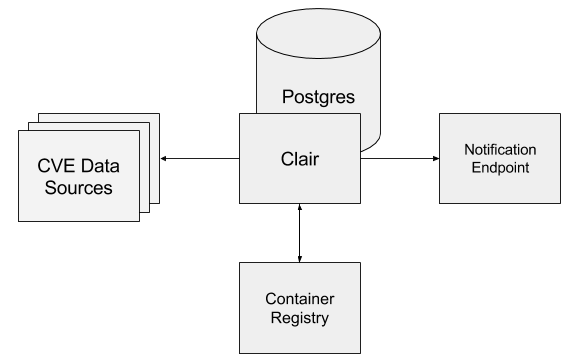| api | ||
| cmd/clair | ||
| config | ||
| contrib | ||
| database | ||
| docs | ||
| Godeps | ||
| img | ||
| notifier | ||
| updater | ||
| utils | ||
| vendor | ||
| worker | ||
| .dockerignore | ||
| .travis.yml | ||
| clair.go | ||
| config.example.yaml | ||
| CONTRIBUTING.md | ||
| DCO | ||
| Dockerfile | ||
| grafana.json | ||
| LICENSE | ||
| NOTICE | ||
| README.md | ||
Clair
Clair is an open source project for the static analysis of vulnerabilities in appc and docker containers.
Vulnerability data is continuously imported from a known set of sources and correlated with the indexed contents of container images in order to produce lists of vulnerabilities that threaten a container. When vulnerability data changes upstream, the previous state and new state of the vulnerability along with the images they affect can be sent via webhook to a configured endpoint. New data sources can be added programmatically at compile-time or data can be injected via HTTP API at runtime.
Our goal is to enable a more transparent view of the security of container-based infrastructure.
Thus, the project was named Clair after the French term which translates to clear, bright, transparent.
Common Use Cases
Manual Auditing
You're building an application and want to depend on a third-party container image that you found by searching the internet.
To make sure that you do not knowingly introduce a new vulnerability into your production service, you decide to scan the container for vulnerabilities.
You docker pull the container to your development machine and start an instance of Clair.
Once it finishes updating, you use the local image analysis tool to analyze the container.
You realize this container is vulnerable to many critical CVEs, so you decide to use another one.
Container Registry Integration
Your company has a continuous-integration pipeline and you want to stop deployments if they introduce a dangerous vulnerability. A developer merges some code into the master branch of your codebase. The first step of your continuous-integration pipeline automates the testing and building of your container and pushes a new container to your container registry. Your container registry notifies Clair which causes the download and indexing of the images for the new container. Clair detects some vulnerabilities and sends a webhook to your continuous deployment tool to prevent this vulnerable build from seeing the light of day.
Hello Heartbleed
Requirements
An instance of PostgreSQL 9.4+ is required. All instructions assume the user has already setup this instance. During the first run, Clair will bootstrap its database with vulnerability data from its data sources. This can take several minutes.
Docker
The easiest way to get an instance of Clair running is to simply pull down the latest copy from Quay.
$ mkdir $HOME/clair_config
$ curl -L https://raw.githubusercontent.com/coreos/clair/config.example.yaml -o $HOME/clair_config/config.yaml
$ $EDITOR $HOME/clair_config/config.yaml # Add the URI for your postgres database
$ docker run quay.io/coreos/clair -p 6060-6061:6060-6061 -v $HOME/clair_config:/config -config=config.yaml
Source
To build Clair, you need to latest stable version of Go and a working Go environment.
$ go get github.com/coreos/clair
$ go install github.com/coreos/clair/cmd/clair
$ $EDITOR config.yaml # Add the URI for your postgres database
$ ./$GOBIN/clair -config=config.yaml
Architecture
At a glance
Vulnerability Analysis
There are two major ways to perform analysis of programs: Static Analysis and Dynamic Analysis. Clair has been designed to perform static analysis; containers never need to be executed. Rather, the filesystem of the container image is inspected and features are indexed into a database. Features are anything that when present could be an indication of a vulnerability (e.g. the presence of a file or an installed software package). By indexing the features of an image into the database, images only need to be rescanned when new features are added.
Data Sources
| Data Source | Versions | Format |
|---|---|---|
| Debian Security Bug Tracker | 6, 7, 8, unstable | dpkg |
| Ubuntu CVE Tracker | 12.04, 12.10, 13.04, 14.04, 14.10, 15.04, 15.10, 16.04 | dpkg |
| Red Hat Security Data | 5, 6, 7 | rpm |
Custom Data Sources
In addition to the default data sources, Clair has been designed in a way that allows extension without forking the project.
Fetchers, which are Go packages that implement the fetching of upstream vulnerability data, are registered in init() similar to drivers for Go's standard database/sql package.
A fetcher can live in its own repository and custom versions of clair can contain a small patch that adds the import statements of the desired fetchers in main.go.

